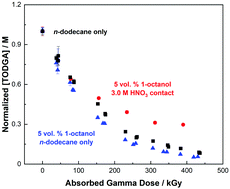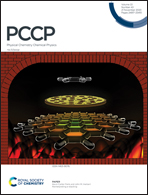Does addition of 1-octanol as a phase modifier provide radical scavenging radioprotection for N,N,N′,N′-tetraoctyldiglycolamide (TODGA)?
Abstract
To mitigate third phase formation in next generation used nuclear fuel reprocessing technologies, the addition of 1-octanol has been trialed. However, contradictory reports on the radiolytic effect of 1-octanol incorporation on separation ligand degradation need to be resolved. Here, 50 mM N,N,N′,N′-tetraoctyldiglycolamide (TODGA) dissolved in n-dodecane was gamma irradiated in the presence and absence of 1-octanol (2.5–10 vol%) and a 3.0 M HNO3 aqueous phase. Radiation-induced TODGA degradation exhibited pseudo-first-order decay kinetics as a function of absorbed gamma dose for all investigated solution and solvent system formulations. The addition of 1-octanol afforded diametrically different effects on the rate of TODGA degradation depending on solvent system formulation. For organic-only irradiations, 1-octanol promoted TODGA degradation (d = 0.0057 kGy−1 for zero 1-octanol present vs. ∼0.0073 kGy−1 for 7.5–10 vol%) attributed to a favourable hydrogen atom abstraction reaction free energy (−0.31 eV) and the ability of 1-octanol to access a higher yield of n-dodecane radical cation (RH˙+) at sub-nanosecond timescales. This was rationalized by determination of the rate coefficient (k) for the reaction of 1-octanol with RH˙+, k = (1.23 ± 0.07) × 1010 M−1 s−1. In contrast, irradiation in the presence of 1-octanol and a 3.0 M HNO3 aqueous phase afforded significant radioprotection (d = 0.0054 kGy−1 for zero 1-octanol present vs. ≤ 0.0044 kGy−1 for >2.5 vol%) that increases with 1-octanol concentration, relative to the single phase, organic-only solutions. This effect was attributed to the extraction of sufficiently high concentrations of HNO3 and H2O into the organic phase by TODGA and 1-octanol as adducts which interfere with the hydrogen atom abstraction process between the 1-octanol radical and TODGA. Our findings suggest that the addition of 1-octanol as a phase modifier will enhance the radiation robustness of TODGA-based separation technologies under envisioned solvent system conditions in the presence of aqueous HNO3.



 Please wait while we load your content...
Please wait while we load your content...
